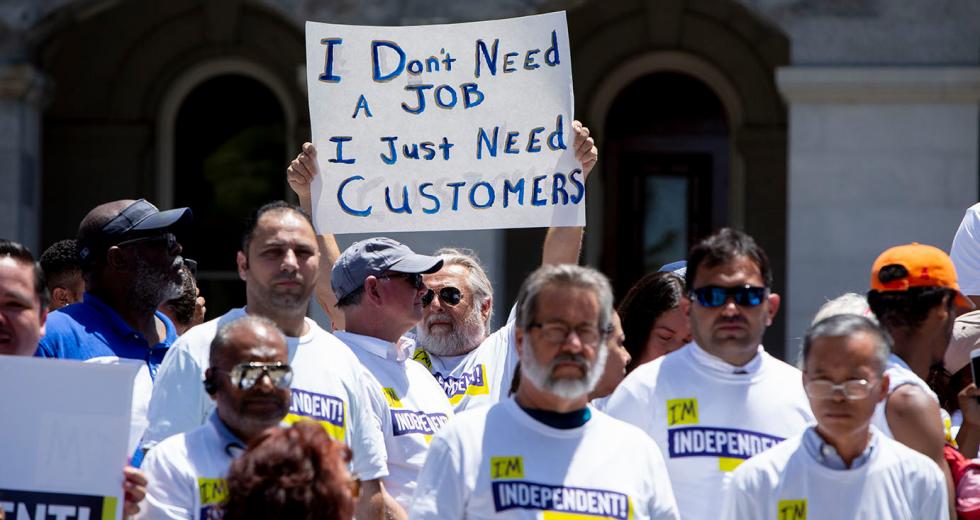Over Labor Day, Gov. Gavin Newsom declared his support for reclassifying an estimated 2 million California workers as employees instead of independent contractors. Powerful unions view Assembly Bill 5 as the year’s signature labor achievement, and the bill is expected to pass the state Senate next week – its last stop before heading to the governor’s desk.
But while Democratic presidential candidates have seized upon labor standards of gig workers as a campaign issue, many questions remain about AB 5’s implications, particularly for Uber and Lyft drivers who number in the hundreds of thousands. Will they become employees when AB 5 becomes law? Will their pay go up? Will they lose flexibility?
Much of this remains in flux. Uber and Lyft say today’s on-demand economy calls for a new, first-in the nation framework, and they want California to forge it. Last week major gig employers seeded $90 million for a ballot measure unless lawmakers find a way to protect their business model. At the same time, the companies acknowledged their drivers deserve better pay, more benefits and greater representation by offering some kind of bargaining with the rideshare industry.
Democrats and labor leaders are working their way through this issue, which means even after AB 5 passes, negotiations will continue. On Wednesday, Politico reported California Labor Federation Chief Officer Art Pulaski has been sharing a road map for how unions might cut through legal uncertainty in order to unionize gig workers. Newsom also says he’d like to craft something new, which would burnish his reputation as a friend to both tech and labor.
But with days left in the current legislative session, political rhetoric continues to build. Here is what we know (and don’t know) so far about this contentious labor dispute:
What happens to Uber and Lyft drivers if they are categorized as employees?
Depends on whom you ask. The companies say it would fundamentally change the rideshare industry’s hiring practices, forcing them to move to “on demand employment,” which has never been done.
It would likely mean the companies would take on fewer drivers, and assign shifts much as a restaurant or retailer might schedule workers. The companies say that drivers would lose a primary attraction of the platform — flexibility.
“We would likely have to exert more control over drivers, telling them where to work, how to work, and who they can work for. Uber would likely hire far fewer drivers than we currently support, and we’d likely have to require a minimum number of hours per week. Scheduling and rigid shifts would become the norm, and Uber would likely prevent drivers from working for other rideshare companies,” Uber wrote recently.
The company says it would block drivers from signing on when the number of drivers outstrips demand, for example in a quiet neighborhood during off-peak hours. Uber and Lyft warn that riders could see higher costs and longer wait times. Riders in transit deserts, they warn, could lose service entirely.
Steve Smith, a spokesman for the California Labor Federation, called these scenarios a “corporate scare tactic” and said nothing prevents companies from maintaining flexibility.
In shifting to employee status, companies would have to offer basic worker protections such as guaranteed minimum wage, overtime pay, contributions to Social Security and Medicare, unemployment and disability insurance as well as workers’ compensation, sick leave and family leave. Workers could also get reimbursed for mileage and maintenance of their vehicles, which doesn’t happen now.
Most likely there would be tradeoffs, writes Harry Campbell, a Long Beach-based driver who authors The Rideshare Guy blog and podcast. Drivers, he predicts, will lose some flexibility and be prevented from driving more than 40 hours a week to avoid overtime, or even 30 hours a week to avoid healthcare benefits. There would be less incentive for Uber and Lyft to offer surge or dynamic pricing, which is now used as a financial incentive to get drivers where demand is high.
On the flip side, drivers would get at least the minimum wage plus mileage reimbursement. Another perk would be getting paid whether or not there’s a passenger in the vehicle, which doesn’t happen now.
“It doesn’t take a rocket scientist to realize that if drivers were guaranteed a minimum wage, you wouldn’t be able to just flip the app on anytime from 10 a.m. to 3 p.m.,” writes Campbell, “because there would be way too many drivers and not enough rides.”
Remind me, what is the Dynamex decision?
Gig companies have been in a legal gray zone since the California Supreme Court issued the so-called Dynamex decision last year making it harder to classify workers as independent contractors. The ruling established a three-part test, or ABC test, for certifying contractors, with the highest hurdle being that the work performed must be outside the company’s core business.
AB 5 by Assemblywoman Lorena Gonzalez, a former labor organizer and a Democrat from San Diego, would codify the court’s decision into state law. From labor’s perspective, this forces gig companies to start paying their fair share of payroll taxes and contribute to disability and unemployment insurance funds for workers. If they don’t, AB 5 would allow state agencies, such as the Labor Commissioner, Franchise Tax Board and Employment Development Department to enforce misclassification.
Workers would also still be able to file their own lawsuits.
How soon might the shift happen?
Although AB 5 would take effect Jan. 1, 2020, don’t expect any immediate changes. Since the inception of Uber and Lyft, rideshare companies have spent millions in litigation and on settlements to try to keep drivers from being classified as employees. This fight is no different.
“If AB 5 passes, it’ll simply be a qualification of existing law,” Uber CEO Dara Khosrowshahi said when asked during an earnings call about California’s effort to reclassify drivers. “It doesn’t immediately transform drivers into employees.”
Expect both legal challenges and political haranguing to continue.
Is there a third way?
This is something to watch for. In the final week of session, Uber and Lyft are lobbying hard to get some kind of carveout and they are pitching a new construct as a win-win-win for the drivers, the gig employers and the state.
Letting gig workers remain independent contractors would lift the costly legal fights Uber and Lyft have been fighting for years over classification and let them work around AB 5. Allowing drivers the right to collective bargaining would, overnight, let unions add more than 200,000 members. And by crafting a third way, California would get to be a trailblazer in fighting for workers in the new economy.
How would gig workers unionize if they remain freelancers?
Good question. Right now there’s a conflict between the state’s Dynamex decision, which presumably would shift drivers from freelancer to employee, and the federal government’s treatment of gig workers as contractors, which makes them ineligible for the right to form a union.
In a confusing twist, Newsom says California could take advantage of this inconsistency.
“Only when the National Labor Relations Act does not cover workers may states act to provide the right to organize a union, allowing workers to bargain for better pay, benefits and working conditions,” he wrote.
Details are scarce but this follows the same logic Pulaski outlined, which calls for gig economy workers to be placed in a new category where they can remain freelancers but access collective bargaining powers.
Would everyone go for this?
Unclear. Labor unions have been split over whether gig companies should even get a carveout. On one side, the Service Employees International Union and Teamsters have been willing to negotiate an alternative in addition to AB 5, an acknowledgement that unions have to evolve with the changing economy.
But the State Building and Construction Trades Council of California is refusing any concessions. Its leader, Robbie Hunter, was removed from Newsom’s future of work commission over the disagreement.
It’s easy to see why: The building trades is an umbrella organization that represents electricians, roofers, painters and a host of other skilled construction workers who currently enjoy prevailing wage, training and job protections. If companies such as Handy were allowed a carveout, it could threaten to turn those careers into gigs.
What about everyone else impacted by AB 5?
With so much talk about Uber and Lyft, it’s worth remembering that AB 5 impacts more than gig workers. The bill would sweep up some workers across industries, from truck drivers and nail technicians to musicians and strippers.
Gonzalez has agreed to leave many workers out. Notably, she has granted exemptions to doctors, insurance agents, real estate agents, hair stylists and barbers who hold booth rental permits, dentists, architects, engineers and accountants.
She also has been making case-by-case concessions for travel agents, graphic designers, grant writers and marketing professionals. Newspaper publishers also have sought an industry exemption since many use freelance writers, photographers, editors and newspaper carriers. The latest version of AB 5 includes an exemption for freelancers as long as they contribute no more than 35 submissions a year.
—
CalMatters.org is a nonprofit, nonpartisan media venture explaining California policies and politics. Comstock’s is a CalMatters media partner.
Recommended For You

Will Assembly Bill 5 Destroy the Gig Economy?
An end-of-session legislative fight has huge implications for companies and their contractors
A momentous Supreme Court decision. A presidential candidate weighing in. A noisy late-August demonstration outside the Capitol. Not Washington, but Sacramento. Not abortion or guns — Dynamex.

How 2 Million Workers Could Be Swept up in a Bill Aimed at the Gig Economy
Do you freelance in California? Have a side hustle? Drive trucks? Work construction? Do nails? Work on political campaigns? Then you should be paying attention to a major employment fight coming to a head in Sacramento.



